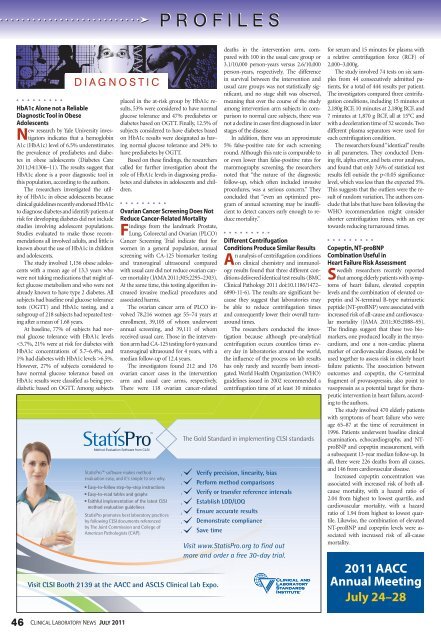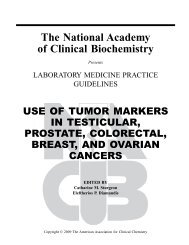Download the entire issue - American Association for Clinical ...
Download the entire issue - American Association for Clinical ...
Download the entire issue - American Association for Clinical ...
Create successful ePaper yourself
Turn your PDF publications into a flip-book with our unique Google optimized e-Paper software.
hba1c alone not a reliable<br />
diagnostic Tool in obese<br />
adolescents<br />
new research by Yale University investigators<br />
indicates that a hemoglobin<br />
A1c (HbA1c) level of 6.5% underestimates<br />
<strong>the</strong> prevalence of prediabetes and diabetes<br />
in obese adolescents (Diabetes Care<br />
2011;34:1306–11). The results suggest that<br />
HbA1c alone is a poor diagnostic tool in<br />
this population, according to <strong>the</strong> authors.<br />
The researchers investigated <strong>the</strong> utility<br />
of HbA1c in obese adolescents because<br />
clinical guidelines recently endorsed HbA1c<br />
to diagnose diabetes and identify patients at<br />
risk <strong>for</strong> developing diabetes did not include<br />
studies involving adolescent populations.<br />
Studies evaluated to make those recommendations<br />
all involved adults, and little is<br />
known about <strong>the</strong> use of HbA1c in children<br />
and adolescents.<br />
The study involved 1,156 obese adolescents<br />
with a mean age of 13.3 years who<br />
were not taking medications that might affect<br />
glucose metabolism and who were not<br />
already known to have type 2 diabetes. All<br />
subjects had baseline oral glucose tolerance<br />
tests (OGTT) and HbA1c testing, and a<br />
subgroup of 218 subjects had repeated testing<br />
after a mean of 1.68 years.<br />
At baseline, 77% of subjects had normal<br />
glucose tolerance with HbA1c levels<br />
6.5%.<br />
However, 27% of subjects considered to<br />
have normal glucose tolerance based on<br />
HbA1c results were classified as being prediabetic<br />
based on OGTT. Among subjects<br />
diagNostiC<br />
46 CliniCal laboratory news July 2011<br />
p r o f i L e s<br />
p r o f i L e s<br />
placed in <strong>the</strong> at-risk group by HbA1c results,<br />
53% were considered to have normal<br />
glucose tolerance and 47% prediabetes or<br />
diabetes based on OGTT. Finally, 12.5% of<br />
subjects considered to have diabetes based<br />
on HbA1c results were designated as having<br />
normal glucose tolerance and 24% to<br />
have prediabetes by OGTT.<br />
Based on <strong>the</strong>se findings, <strong>the</strong> researchers<br />
called <strong>for</strong> fur<strong>the</strong>r investigation about <strong>the</strong><br />
role of HbA1c levels in diagnosing prediabetes<br />
and diabetes in adolescents and children.<br />
ovarian cancer screening does not<br />
reduce cancer-related mortality<br />
findings from <strong>the</strong> landmark Prostate,<br />
Lung, Colorectal and Ovarian (PLCO)<br />
Cancer Screening Trial indicate that <strong>for</strong><br />
women in a general population, annual<br />
screening with CA-125 biomarker testing<br />
and transvaginal ultrasound compared<br />
with usual care did not reduce ovarian cancer<br />
mortality (JAMA 2011;305:2295–2303).<br />
At <strong>the</strong> same time, this testing algorithm increased<br />
invasive medical procedures and<br />
associated harms.<br />
The ovarian cancer arm of PLCO involved<br />
78,216 women age 55–74 years at<br />
enrollment, 39,105 of whom underwent<br />
annual screening, and 39,111 of whom<br />
received usual care. Those in <strong>the</strong> intervention<br />
arm had CA-125 testing <strong>for</strong> 6 years and<br />
transvaginal ultrasound <strong>for</strong> 4 years, with a<br />
median follow-up of 12.4 years.<br />
The investigators found 212 and 176<br />
ovarian cancer cases in <strong>the</strong> intervention<br />
arm and usual care arms, respectively.<br />
There were 118 ovarian cancer-related<br />
StatisPro software makes method<br />
evaluation easy, and it’s simple to see why.<br />
■ Easy-to-follow step-by-step instructions<br />
■ Easy-to-read tables and graphs<br />
■ Faithful implementation of <strong>the</strong> latest CLSI<br />
method evaluation guidelines<br />
StatisPro promotes best laboratory practices<br />
by following CLSI documents referenced<br />
by The Joint Commission and College of<br />
<strong>American</strong> Pathologists (CAP).<br />
Visit CLSI Booth 2139 at <strong>the</strong> AACC and ASCLS <strong>Clinical</strong> Lab Expo.<br />
deaths in <strong>the</strong> intervention arm, compared<br />
with 100 in <strong>the</strong> usual care group or<br />
3.1/10,000 person-years versus 2.6/10,000<br />
person-years, respectively. The difference<br />
in survival between <strong>the</strong> intervention and<br />
usual care groups was not statistically significant,<br />
and no stage shift was observed,<br />
meaning that over <strong>the</strong> course of <strong>the</strong> study<br />
among intervention arm subjects in comparison<br />
to normal care subjects, <strong>the</strong>re was<br />
not a decline in cases first diagnosed in later<br />
stages of <strong>the</strong> disease.<br />
In addition, <strong>the</strong>re was an approximate<br />
5% false-positive rate <strong>for</strong> each screening<br />
round. Although this rate is comparable to<br />
or even lower than false-positive rates <strong>for</strong><br />
mammography screening, <strong>the</strong> researchers<br />
noted that “<strong>the</strong> nature of <strong>the</strong> diagnostic<br />
follow-up, which often included invasive<br />
procedures, was a serious concern.” They<br />
concluded that “even an optimized program<br />
of annual screening may be insufficient<br />
to detect cancers early enough to reduce<br />
mortality.”<br />
different centrifugation<br />
conditions Produce similar results<br />
an analysis of centrifugation conditions<br />
on clinical chemistry and immunology<br />
results found that three different conditions<br />
delivered identical test results (BMC<br />
<strong>Clinical</strong> Pathology 2011 doi:10.1186/1472–<br />
6890-11-6). The results are significant because<br />
<strong>the</strong>y suggest that laboratories may<br />
be able to reduce centrifugation times<br />
and consequently lower <strong>the</strong>ir overall turnaround<br />
times.<br />
The researchers conducted <strong>the</strong> investigation<br />
because although pre-analytical<br />
centrifugation occurs countless times every<br />
day in laboratories around <strong>the</strong> world,<br />
<strong>the</strong> influence of <strong>the</strong> process on lab results<br />
has only rarely and recently been investigated.<br />
World Health Organization (WHO)<br />
guidelines <strong>issue</strong>d in 2002 recommended a<br />
centrifugation time of at least 10 minutes<br />
The Gold Standard in implementing CLSI standards<br />
Verify precision, linearity, bias<br />
Per<strong>for</strong>m method comparisons<br />
Verify or transfer reference intervals<br />
Establish LOD/LOQ<br />
Ensure accurate results<br />
Demonstrate compliance<br />
Save time<br />
Visit www.StatisPro.org to find out<br />
more and order a free 30-day trial.<br />
<strong>for</strong> serum and 15 minutes <strong>for</strong> plasma with<br />
a relative centrifugation <strong>for</strong>ce (RCF) of<br />
2,000–3,000g.<br />
The study involved 74 tests on six samples<br />
from 44 consecutively admitted patients,<br />
<strong>for</strong> a total of 444 results per patient.<br />
The investigators compared three centrifugation<br />
conditions, including 15 minutes at<br />
2,180g RCF, 10 minutes at 2,180g RCF, and<br />
7 minutes at 1,870 g RCF, all at 15°C and<br />
with a deceleration time of 32 seconds. Two<br />
different plasma separators were used <strong>for</strong><br />
each centrifugation condition.<br />
The researchers found “identical” results<br />
in all parameters. They conducted Deming<br />
fit, alpha error, and beta error analyses,<br />
and found that only 3.6% of statistical test<br />
results fell outside <strong>the</strong> p
















